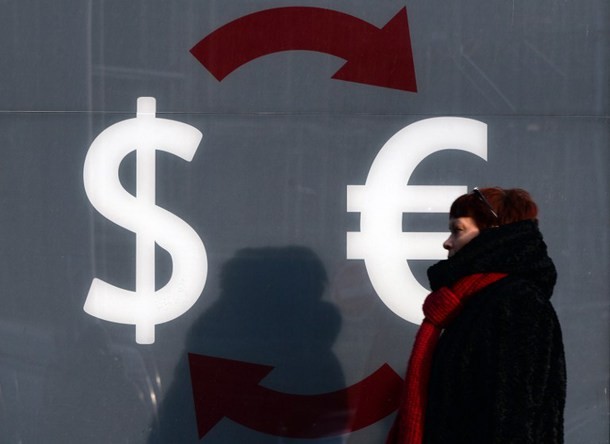Sanctions hit rouble hard
Post on: 18 Июнь, 2015 No Comment

Related Articles
Moscow — Russia’s rouble struck a new all-time low against the dollar on Monday, breaking a psychological level under the weight of Western sanctions and major shifts on global financial markets.
The rouble fell below 40 to the dollar for the first time, and the central bank stepped in to defend the Russian currency when it breached its trading band against a dollar-euro basket.
This action followed similar interventions last week as the rouble suffered from the combined effects of the sanctions imposed over Moscow’s role in the Ukraine crisis, plus two shifts on international markets — falling oil prices and a general flow of capital out of emerging markets.
As well as touching a new low of 40.05 against the dollar, it hit a low of 44.60 against the dollar-euro basket which the central bank uses to gauge the rouble’s exchange rate. While it later recovered in mid-afternoon trading, analysts forecast further weakness.
Russian firms shut out of international capital markets by the sanctions have been buying up dollars, pushing the rouble down by around 18% since the start of the year, and the latest drop raised the possibility that private citizens might join in.
The level of 40 to the dollar is widely perceived as an important psychological level, and could ignite concerns among households and fuel the flight of rouble savings into hard currency, VTB Capital analyst Maxim Korovin said in a note.
A sharp slowdown in the Russian economy, which is officially forecast to grow by just 0.5% this year as the sanctions encourage capital flight and dampen investment, is adding to the sense of gloom.
The market understands that Western sanctions won’t be withdrawn given current geopolitical news, but you have to get foreign currency somewhere, said Pyotr Neimyshev, a currency dealer at Otkritie bank in Moscow. At the moment the central bank is the only one (selling) foreign currency, exporters are holding on to it.
World oil prices rose on Monday but only after benchmark Brent crude fell nearly 5% last week, its steepest loss since April 2013, as a generally strong dollar, weak demand and ample supply weighed on prices.
Russia relies heavily on energy sales for state revenue and has based its 2015-2018 budget on an oil price of around $100 a barrel, already well above its main Urals blend which traded on Monday at about $91.
On top of that global investors are pulling money out of emerging markets generally, moving it into dollars as they start to price in the US Federal Reserve calling time on the easy money policies which it brought in as economic life support after the financial crisis of 2008.
The Russian central bank said on Monday it had shifted its target exchange-rate corridor for the rouble by 10 kopecks as of Friday, to 35.50 to 44.50 roubles against the basket.
This implies the bank has spent at least $700m defending the rouble since it last moved the corridor in early in May. The bank’s stated policy is to move the corridor by five kopecks every time it spends $350m.
It was not clear how much currency the central bank had spent on Monday, when the rouble breached the new boundaries of its trading band within the first hour of trading, since the bank releases such data with a time lag of two days.
Healthy reserves
Russia has healthy gold and foreign exchange reserves of about $450bn that it can draw on to support the rouble, although the central bank aims to let the currency float freely from next year as part of its shift towards an inflation-targeting regime.
In mid-afternoon trading, the rouble recovered to trade 0.29% stronger from Friday’s close at 39.84 against the dollar but was 0.18% lower against the euro at 50.02. That left it 0.05% stronger against the basket at 44.41.
The pressure on the rouble will continue this week, forcing the regulator to sell further foreign currency. You can no longer ignore prices for Brent crude falling below $92 a barrel, Dmitry Polevoy, chief economist for Russia and CIS at ING Bank in Moscow, said in a note.
If current oil prices stay like this until the end of the year, we don’t rule out USD/RUB exceeding 41-42.00.
The West originally imposed sanctions over Russia’s annexation of Crimea in March, and has since the tightened trade and financial measures over support from pro-Moscow rebels in eastern Ukraine.
John Hardy, head of FX Strategy at Saxo Capital Markets, said in a note that without a rapprochement with the West, heavy central bank interventions or capital controls, the rouble could fall to 45 against the dollar within the next six months.
Crude oil prices at these levels or lower and any deepening of the gloom spreading across the world’s equity bourses of late could keep the rouble in a negative spiral for some time to come, he wrote.
Russian shares were significantly firmer on Monday, supported by bullish sentiment on international stock markets after stronger-than-expected US jobs data eased concerns about global economic growth.
At 14:20, the dollar-denominated RTS index was up 2.7% to 1 121 points, while its rouble-based peer MICEX traded 2.4% higher at 1 418 points. Top bank Sberbank was 3.2% higher and state gas company Gazprom was up 2.6%.














